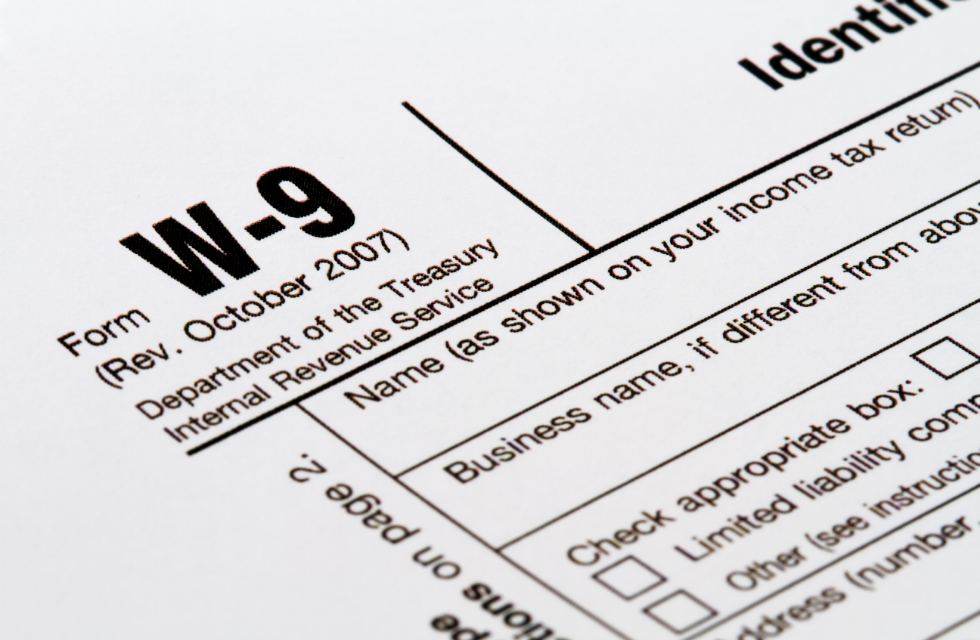Wondering if you should file a W-9 or 1099? You’re not alone! A lot of people get confused about the difference between these two forms. We have come up with this guide to clarify the difference between both forms to enable you to file the right form for your business. With our easy-to-follow guide, you'll be able to determine which form is best for you in just a few minutes.
When it comes to taxes, there can be a lot of confusion about which forms to use. This is especially true when it comes to the difference between a W-9 Vs 1099 form. So, what's the difference between these two tax forms?
The biggest difference between W-9 Vs 1099 is who they are used for:
- The Form W-9 is a document that an independent contractor fills out and provides to their employer.
- A 1099 form, on the other hand, is a crucial piece of information for both the IRS and state tax authorities. It details how much an employer pays to their independent contractor, which can help them with things like taxes or healthcare coverage if they are not considered full-time employees by law.
This guide will also facilitate the employers' work who are assigned as independent contractors, as need to know more about the appropriate tax-related forms.
So, what is the distinction between W-9 Vs 1099 forms and the kind of financial information each form contains? Here's a rundown on the basics for both, including how to file either one if you're self-employed or an entrepreneur with lots going on in a business.
Table Of Contents
- What is Form 1099?
- What is Form W-9?
- Why Do You Require a W-9 for 1099?
- Who Should Get These Forms?
- W-9 Vs. 1099- Penalties For not Filing Such Forms
- W-9 Vs. 1099- How to File/ Process of Filing.
- How to Fill Out Form W-9?
- How to Fill Out Form 1099?
- W-9 Vs. 1099- The Deadlines to File
- Key Takeaways
What is Form 1099?
The IRS requires businesses to file Form 1099 with the agency if they pay someone for services rendered. Therefore, an independent contractor who receives this form from their employer must also report it on their tax return, even though it may be considered miscellaneous income.
The information about how much was earned or generated by doing work oneself can help them determine whether capital gains should apply in certain circumstances during tax season.
What is Form W-9?
The IRS Form W-9 is a quick and easy way for freelancers to share their information with clients. It should be completed at the onset of work or upon first meeting as an independent contractor. If not already done so, this ensures no miscommunication issues between both parties because you know what your employer needs from yourself.
Why Do You Require a W-9 for 1099?
The IRS has strict guidelines for correctly completing a 1099 form, and you must use the right information. Technically, it is not imperative for an employer to ask for a W-9 from independent contractors.
But in theory, any method through which they obtain their taxpayer identification number or Social Security Numbers are valid as long as it is used by the company and not by just one person in order for them to make sure that no false information gets submitted with taxes owed on behalf of them when filing tax returns each year. Employers still highly recommend using these correct forms because failing this could lead to penalties according to law.
Who Should Get These Forms?
When you're an independent contractor, it's important to keep up with your taxes. You need a copy of every form that any client or employer gave in order to get them filed properly and avoid problems later on down the line.
However, there is an exception to this. The form is not required if the employee's pay decreases below $600 in any of these categories:
- Awards and prizes.
- Payments made to healthcare professionals or an attorney.
- Crop insurance proceeds.
- Cash payments for aquatic life purchases and all forms of payment for other fishing boats proceed by check, credit card, or debit card at our secure online checkout.
- Cash paid to an individual taxpayer, a partnership, or an estate firm by a national principal contract.
- This is a list of any other miscellaneous income payments, including non-employee for services provided.
The Form W-9 is a tax form that reports the contractor's income to the IRS. The 1099 forms are sent out by contractors who want their payer, i.e., you know how much they earn and what kind of services were performed for them to make sure no one overpays or undervalues anything at all.
W-9 Vs. 1099- Penalties For not Filing Such Forms
The IRS has stringent penalties for not filing 1099, including fines and prison time. To avoid these consequences, employers should provide their employees with all documentation they receive from contractors or others who pay them in cash so that there is no late submission on tax returns when dealing solely within this industry.
The due date for filing a 1099 statement depends on the form you're preparing. The deadline to submit an annual report with information about all your contractors is January 31, but if it's not done by this date, there are penalties Like $560 per contractor also expenses like mailing costs (which can easily reach thousands) as well. When five different people work together in one company without being given correct paperwork; their fine could total up to $2800 altogether.
The IRS is tough on anyone who doesn't collect a W-9 from contractors or freelancers. If you hire someone and they fail to give accurate tax information, the fine can be as much as $50 per attempt. For businesses with multiple employees, this becomes an even bigger issue because it's easy for them not to provide enough documentation when one person fails in their responsibility now they will need two fines instead of just one ($100).
W-9 Vs. 1099- How to File/ Process of Filing.
The W-9 and 1099 are straightforward to fill out, making them easy for business owners. They provide crucial tax information in an organized way that makes it easily understandable. Let's know in detail!
How to Fill Out Form W-9?
- In box 1, write your full legal name, which is likely the same as on files with tax returns. Do not include middle names unless they are also mentioned in documentation, such as an SSN or driver's license.
- You need to mention your business name or disregarded entity name in Box 2; if you have one in addition to your legal one. For example, a sole proprietor who runs their own company under a different name should also put that on here.
- In box 3, you need to check if your business type aligns with these five options: individual/sole proprietor, single-member LLC (with limited liability), C Corporation S Corporations, or partnership.
- In box 4, you can detail any exemptions that apply to your situation. The rare exceptions are corporations who have been granted backup withholding or payees exempt from reporting according to the Foreign Account Tax Compliance Act, but these circumstances aren't typically found among freelancers.
- In box 5 and 6 write down your correct address.
- In box 7, which says “List Account Number(s),” is generally optional unless you're asked directly by the person who requests W-9.
- Part I is next when you are ready to move from the freelancer or sole proprietor information page. Here provide your Social Security number and if you are a business with no EIN yet (and have applied for one), write "Applied."
- Coming to Part 2, even if you are exempt from backup withholding, it's good to fill out this form anyway. The IRS may contact us and tell us otherwise if they have questions about any of the statements, so be ready! Your signature will mean that all four statements are true.
- File the completed form with the business entity that requested it.
How to Fill Out Form 1099?
- The IRS requires you to fill out five copies of Form 1099: one for yourself, two as payments with recipients (the independent contractor), and three more destined only toward paperwork.
- In the large box on the top left, you need to write your business name, address, and phone number.
- In the two boxes below the address box, you must write your TIN and your recipient's TIN where indicated.
- You must enter the recipient's name and address below the TIN boxes.
- In box 1, list all money paid as rent except if it's to a corporation.
- In box 2, enter all money paid as royalties on intellectual property or oil properties. If you paid at least $10 in royalties to the recipient, it must be recorded and reported even if it is less than 10%.
- In box 3, you can now enter all money paid directly to independent contractors for their services. This includes payments from previous tax years as well, so be sure and check if there are any taxes associated with it. All other items explicitly marked (i.e., prizes) will still go into whichever box best suits them until 2020, but keep track of how much each group is worth before deciding. Once numbers change, everything might look different again.
- While making payments to independent contractors, you are not required to withhold taxes so that you can leave box four empty or blank.
- If you have already paid fishing boat proceeds, enter those in box 5.
- Payments related to healthcare needs or attorneys should be put under box 6.
- Check box 7 only if all the provided statements are true.
- The IRS has detailed instructions for filling out this form, so be sure and read them carefully. Box 8-14 does not apply to most businesses because of the rare instances when it does come into play; however there are guidelines on how you can fill that box if needed.
- Boxes 15-17 are for businesses that partake in the Combined Federal/State Filing Program. These instructions may be helpful, but you're not required to complete them according to IRS regulations.
- Also note the IRS changes Form 1099 every year, so make sure you’re using the correct version for this tax season.
- When you have finalized your business form, file it with the appropriate authorities. Make sure to secure copies for yourself and store one copy securely at home or in a safe place where no other person will be able to access them.
W-9 Vs. 1099- The Deadlines to File
You have to file Form 1099 with payments you made to non-employees during the 2020 tax year by January 31 2022. For other types of reported payments, their deadline is February 28, 2022. Forms need timely filing so that taxes can be properly assessed and collected from persons liable for them.
On the other hand, the IRS has no deadlines for submitting Form W-9 because the agency does not collect this information. Be sure to file it with your client as soon as possible if you are an independent contractor who starts work after December 31 and won't provide them a copy of their own form until January 31. That way both parties will know what is expected from now on in regards to reporting requirements.
Now you can see there are some key differences between a W-9 Vs. 1099 form, and you need to decide which one to fill out depending on your tax situation. In this article, we have tried to cover those critical differences between W-9 Vs. 1099 forms and have given you a proper understanding of the forms and how to use them.
We hope this article was helpful to you in clearing up some of your confusion around W-9 Vs. 1099 forms. If you are not sure which form to use, or have any other questions about your taxes, be sure to consult with a qualified accountant or tax specialist.
How Deskera Can Assist You?
As a business, you must be diligent with the employee payroll system. Deskera People allows you to conveniently manage payroll, leave, attendance, and other expenses. Generating payslips for your employees is now easy as the platform also digitizes and automates HR processes.
Key Takeaways
The following are the key takeaways from the above:
- Form W-9 is required to be filled by an independent contractor/ freelancers. Whereas Form 1099 is typically filled by the employer.
- Form W-9 facilitates collection of tax related information accurately by the employer. Form 1099 contains details of the payment made by the employerto their independent contractor.
- Form W-9 is not required to be submitted with IRS, while Form 1099 is submitted with IRS.
- Both the Form W-9 and 1099 can be downloaded from the IRS website.
- There are various sub-types of 1099 Form.
- While Form W-9 is typically submitted before commencement of work by independent contractor, Form 1099 is required to be submitted on annual basis, before the tax season ends.
Related Articles













